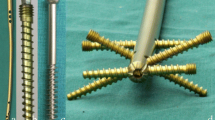Summary.
Age, high physiological load and the great number and different fracture types of the proximal femur are the main challanges for implants used in the management of these fractures. For use in these types of fracture with immediate restoration of full weight-bearing capacity and for reduction of the intra- and postoperative complication rate, the gliding nail was developed. The development is based on a large number of experimental and clinical examinations of per- and subtrochanteric fractures. The advantages of an intramedullary implant and the gliding screw systems are combined with increased moment of resistance of the double-T femor-neck blade profile. We performed a prospective clinical evaluation of the first 186 patients with per- and subtrochanteric fractures who were treated between 15 September 1994 and 29 February 1996 in the Aschaffenburg Trauma Department with a follow-up examination at least 3 months after the operation. The intraoperative complication rate was 1.1 %. The postoperative complication rate was 4.9 %. Change of the blade because of fracture impaction and tractus iliotibialis problems was the most frequent problem with 2.2 %. The most severe complication (1.1 %) were caused by subchondral placement of the blade in the cranial one-third of the femur head. In these cases reosteosynthesis was indicated. Ninety-three percent of the survivors were able to return home. The rate of bed-ridden patients (7.7 % and 11.7 %) was not very different before or after the operation. However, many patients do not reach the condition they had before the fracture and they are one step worse in mobility and social independence.
Zusammenfassung.
Das hohe Alter, die hohe Belastung des proximalen Femurendes und die Vielzahl der Frakturformen stellen hohe Anforderungen an Implantate zur Versorgung per- und subtrochanterer Femurfrakturen. Zur universellen Anwendung bei diesen Frakturformen und zur Verminderung der Komplikationsrate bei sicherer primärer Belastungsstabilität wurde auf Grund umfangreicher experimenteller und klinischer Untersuchungen der Gleitnagel entwickelt. Er vereinigt die Vorteile eines intramedullären Implantats mit Laschengleitprinzip mit denen das Doppel-T-Klingenprofils des Schenkelhalskraftträgers. Die prospektive klinische Analyse der ersten 186 Patienten, mit einer Nachuntersuchung frühestens 3 Monate nach Operation, die vom 15. 9. 1994 bis zum 29. 2. 1996 im Klinikum Aschaffenburg behandelt wurden, zeigte eine intraoperative Komplikationsrate von 1,1 %. Die postoperative Komplikationsrate betrug 4,9 %, wobei ein Klingenwechsel bei starker Einstauchung und Tractusreizung mit 2,2 % die bei weitem wichtigste Ursache darstellte. Die schwerwiegendsten Folgen hatte die subchondrale Plazierung der Klinge im cranialen Kopfdrittel (1,1 %), wo eine Reosteosynthese erforderlich war. In 93 % konnten die überlebenden Patienten in ihr prästationäres Umfeld entlassen werden. Die Rate bettlägeriger Patienten (7,7 bzw. 11,7 %) und auf Pflege angewiesener Patienten (14 bzw. 18,3 %) war prä- und postoperativ annähernd gleich. Viele Patienten weisen jedoch eine Gangqualitätsverschlechterung und soziale Selbständigkeitseinschränkung um eine Stufe auf.
Similar content being viewed by others
Author information
Authors and Affiliations
Rights and permissions
About this article
Cite this article
Friedl, W., Göhring, U., Fritz, T. et al. Die Gleitnagelosteosynthese Ein neues universell einsetzbares Implantat zur Versorgung per- und subtrochanterer Femurfrakturen. Chirurg 69, 191–197 (1998). https://doi.org/10.1007/s001040050395
Issue Date:
DOI: https://doi.org/10.1007/s001040050395




